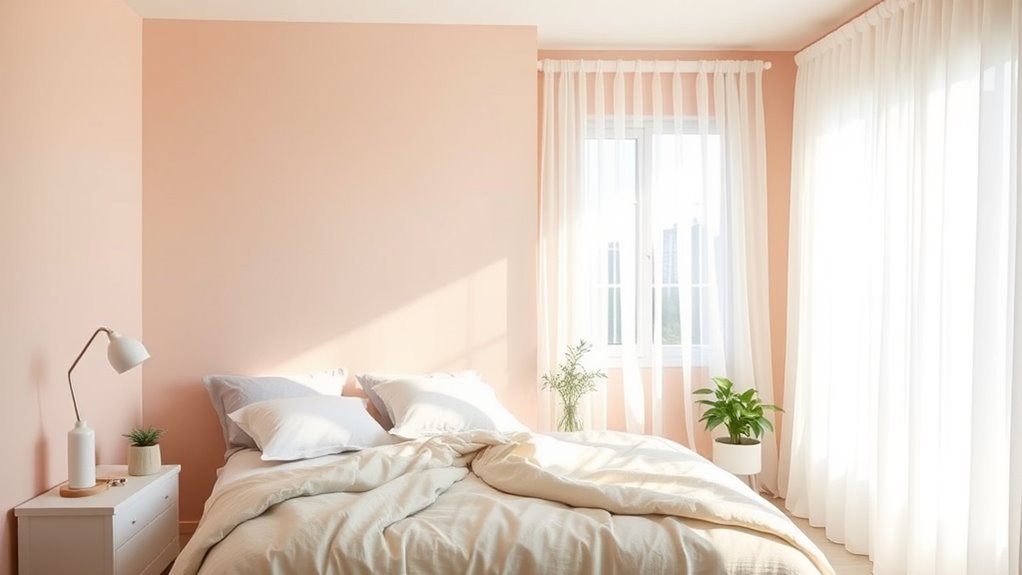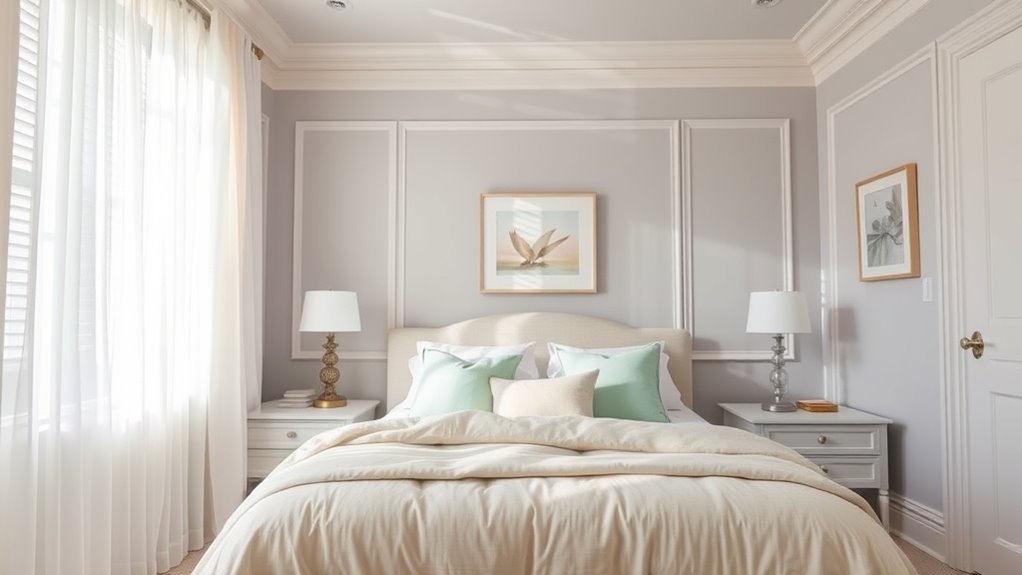For a calming bedroom, opt for soft, muted colors like gentle blues, calming greens, or warm neutrals like beige, light gray, or creamy white. These hues help reduce stress, promote relaxation, and create a peaceful environment perfect for rest. Cool tones with blue or green undertones are especially effective, while natural light can enhance their soothing qualities. Keep exploring how to choose the best hues to transform your space into a tranquil retreat.
Key Takeaways
- Opt for soft blues like powder blue or slate to promote relaxation and reduce stress.
- Incorporate calming greens such as sage or seafoam for a balanced, restful environment.
- Use neutral shades like warm beiges, light grays, or creamy whites as versatile, soothing backdrops.
- Choose muted, pastel tones to foster tranquility and avoid overstimulation.
- Enhance the calming effect with natural lighting and harmonious color combinations.

Creating a calming bedroom starts with choosing the right paint colors. The colors you select set the tone for relaxation and help you unwind after a long day. To achieve this, you should focus on soothing color palettes that promote tranquility and restfulness. Understanding color psychology principles can guide you in picking hues that evoke calmness and serenity. Soft, muted shades are often the best choice because they don’t overstimulate the senses and create a peaceful environment. When you stick to these principles, you’re more likely to craft a space that encourages deep, restful sleep.
Start by considering colors like gentle blues, calming greens, and soft neutrals. Blues are known for their ability to lower stress and promote a sense of calm, making them perfect for bedrooms. Opt for shades like powder blue or slate that aren’t too bright or overwhelming. Greens, especially those inspired by nature, foster a feeling of balance and renewal. Think of sage or seafoam tones that bring a touch of the outdoors inside, helping you feel grounded and relaxed. Neutrals such as warm beiges, light grays, and creamy whites serve as versatile backdrops that make the space feel open and airy without creating visual noise. These colors work well with various accent pieces and bedding, allowing you to customize your calming atmosphere easily.
When choosing paint colors, keep in mind the principles of color psychology. For example, cool tones tend to be more relaxing than warm hues, so lean towards shades that have blue or green undertones. Avoid overly bright or intense colors, as they can stimulate your mind rather than soothe it. Instead, select muted, soft tones that promote a sense of quiet and comfort. Additionally, consider the lighting in your space—natural light can enhance the soothing qualities of your chosen colors, making them appear even more calming during the day. Incorporating color harmony principles can also help ensure your color choices work well together and enhance the overall tranquility of your bedroom.
You should also think about the psychological effects of the colors. Light shades tend to make a room feel larger and more open, which can decrease feelings of claustrophobia or anxiety. Conversely, darker but still muted tones can add coziness and intimacy without feeling oppressive. The key is balance; pick colors that resonate with your personal sense of calm while adhering to the principles that promote relaxation. With the right soothing color palettes and an understanding of color psychology principles, you’ll create a bedroom that’s not just beautiful but also a true retreat for rest and rejuvenation.
Frequently Asked Questions
Do Matte or Satin Finishes Promote More Relaxation?
You might wonder if matte or satin finishes promote more relaxation. Matte finishes, with their low sheen effects and soft textures, tend to create a calming, subdued atmosphere, reducing glare and visual noise. Satin finishes have a slight sheen, offering a smooth texture that’s easier to clean but can reflect more light. For a relaxing space, matte finishes are ideal, as they foster a tranquil, cozy environment without the distraction of shine.
How Do Natural Light Levels Affect Calming Paint Choices?
Natural light plays a big role in how you perceive your paint colors. If your bedroom has abundant natural light, opt for softer, cooler shades like blues or greens, which stay calming without feeling overwhelming. In spaces with limited natural light, warmer or darker hues can make the room feel cozy yet still soothing. Remember, natural light influences paint perception, so test colors at different times to find your perfect calming shade.
Are There Any Paint Colors to Avoid in a Calming Bedroom?
You should avoid paint colors with distracting patterns or overly bold accent walls in a calming bedroom. These elements can draw your attention and disrupt relaxation. Stay away from bright reds, neon shades, or complex patterns that create visual clutter. Instead, choose soft, muted hues that promote tranquility. Keeping walls simple and subtle helps you unwind and creates a peaceful environment, perfect for rest and rejuvenation.
Can Wall Color Influence Sleep Quality?
Imagine you paint your bedroom a soft blue, known for its calming effects. Wall color can influence sleep quality through psychological effects and color psychology, as certain hues promote relaxation and reduce stress. When you choose soothing shades, you foster a tranquil environment that helps your mind unwind, making it easier to fall asleep and enjoy restorative rest. Your color choices truly impact your sleep experience.
How Often Should I Repaint to Maintain a Calming Atmosphere?
You should aim to repaint your bedroom every 3-5 years to maintain a calming atmosphere. Establish a repainting schedule based on how quickly your walls show wear or discoloration. Follow maintenance tips like cleaning walls regularly and inspecting for chips or stains. This helps keep your space fresh and soothing, ensuring your calming environment stays inviting. Staying consistent with your repainting schedule guarantees your bedroom remains a peaceful retreat.
Conclusion
Choosing the right paint color transforms your bedroom into a sanctuary. Think of it as tuning a delicate instrument—each hue resonates differently, creating harmony or discord. When I painted my own bedroom soft blue, it felt like stepping into a peaceful lakeside retreat. Research shows calming colors can reduce stress and improve sleep. So, pick a shade that speaks to your soul. After all, your bedroom should be a refuge where serenity naturally blooms.









